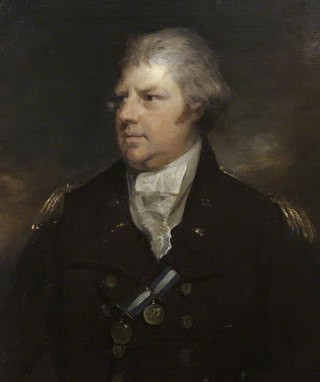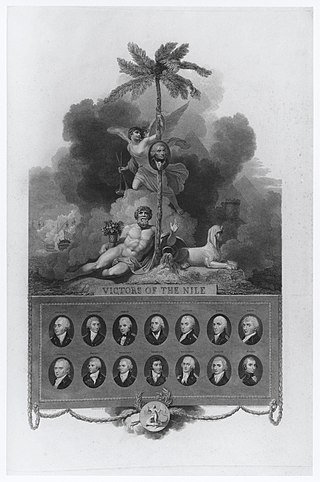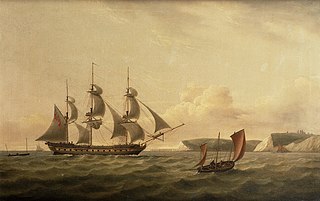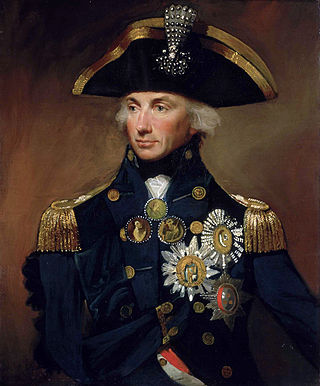Related Research Articles

The Battle of Trafalgar was a naval engagement that took place on 21 October 1805 between the British Royal Navy and the combined fleets of the French and Spanish Navies during the War of the Third Coalition of the Napoleonic Wars (1803–1815).

The Battle of Copenhagen of 1801, also known as the First Battle of Copenhagen to distinguish it from the Second Battle of Copenhagen in 1807, was a naval battle in which a British fleet fought and defeated a smaller force of the Dano-Norwegian Navy anchored near Copenhagen on 2 April 1801. The battle came about over British fears that the powerful Danish fleet would ally with France, and a breakdown in diplomatic communications on both sides.

The history of Copenhagen dates back to the first settlement at the site in the 11th century. From the middle of the 12th century it grew in importance after coming into the possession of Bishop Absalon, and the city was fortified with a stone wall during the 13th century. The harbour and the excellent possibilities for herring fishing contributed to Copenhagen's growth and development into an important trading centre. It was repeatedly attacked by the Hanseatic League as the Germans became aware of its expansion. In 1254, it received its charter as a city under Bishop Jakob Erlandsen.
Captain Sir James Brisbane, CB was a British Royal Navy officer of the French Revolutionary and Napoleonic Wars. Although never engaged in any major actions, Brisbane served under both Lord Howe and Horatio Nelson and performed important work at the Cape of Good Hope, prior to the Battle of Copenhagen and in the Adriatic campaign of 1807–1814. In later life Brisbane became commander-in-chief in the East Indies. He contracted dysentery in Burma and arrived in Port Jackson in Sydney aboard HMS Warspite, where he died on 19 December 1826. He was a cousin of General Sir Thomas Brisbane who had earlier been governor of New South Wales.

Edward Riou FRS was an officer of the Royal Navy who served during the French Revolutionary Wars under several of the most distinguished naval officers of his age and won fame and honour for two incidents in particular.

Admiral Sir Thomas Foley GCB was a Royal Navy officer and "Hero of the Battle of the Nile".

Admiral Sir Hyde Parker was an admiral of the British Royal Navy.

Admiral Sir Robert Waller Otway, 1st Baronet, GCB was a senior Royal Navy officer of the early nineteenth century who served extensively as a sea captain during the Napoleonic War and later supported the Brazilian cause during the Brazilian War of Independence. During his long service, Otway saw action across Europe and in North America and was rewarded in his retirement with a knighthood, baronetcy, and position as a courtier within the Royal Household.

"Band of brothers" was a phrase used by Rear-Admiral Horatio Nelson to refer to the captains under his command just before and at the Battle of the Nile in 1798. The phrase, taken from Shakespeare's St Crispin's Day Speech of Henry V, later came to be more generally applied to his relationship with the captains and men under his command, such as at the Battle of Trafalgar.

The English Wars were a series of conflicts pitting the United Kingdom and Sweden against Denmark-Norway as part of the Napoleonic Wars. It is named after England, the common name in Scandinavia for the United Kingdom, which declared war on Denmark-Norway due to disagreements over the neutrality of Danish trade and to prevent the Danish fleet falling into the hands of the First French Empire. It began with the Battle of Copenhagen (1801) and its latter stage from 1807 onwards was followed by the Gunboat War, the Dano-Swedish War of 1808–09 and the Swedish invasion of Holstein in 1814.
Sir John Phillimore CB was an officer of the Royal Navy who saw service during the French Revolutionary and Napoleonic Wars. He was involved in several notable actions during his active career, taking part in both Battles of Copenhagen, sending Sir Hyde Parker's famous signal to Nelson in the first, and fighting off Danish gunboats in the second. He went on to win a hard-fought victory over a French frigate in 1814 and reaped the rewards. He was at times a controversial figure, causing a scandal when he thrashed the naval historian William James with a stick for apparently badly representing Phillimore's conduct, and on another occasion inviting rebuke from the Navy Board for his request for more paint for his ship. He nevertheless became an aide-de-camp to the young Queen Victoria, and took important steps to reform how the lower ranks and ordinary seamen were treated in the Navy.

Vice-Admiral Sir George Murray KCB was an officer in the Royal Navy who saw service in a wide range of theatres and campaigns. His active naval career spanned the American War of Independence and the French Revolutionary and Napoleonic Wars. Murray served under many of the most notable commanders of his age and participated in several of their greatest victories. He was with Parker and Howe in the West Indies and North America, Johnstone and Hughes in the East Indies, Jervis at Cape St Vincent, Nelson at Copenhagen, and took part in a host of other actions and engagements. Temporarily a captive of the French he was a keen scholar and spent time learning the French language and their naval customs, as well as being a competent surveyor, experience that was to help him in later life. He had a particularly enduring friendship with Nelson, who personally requested his services as his captain of the fleet. It was only chance that prevented Murray from serving as such at Trafalgar. With Murray absent, Nelson declined to appoint a replacement, one biographer reasoning that "none but Murray would do".
Events in the year 1801 in Norway.

HMS Amazon was a 38-gun fifth-rate Amazon-class frigate of the Royal Navy. She served during the French Revolutionary and Napoleonic Wars under several notable naval commanders and played a key role in the Battle of Copenhagen under Edward Riou, who commanded the frigate squadron during the attack. After Riou was killed during the battle, command briefly devolved to John Quilliam. Quilliam made a significant impression on Horatio Nelson, who appointed Quilliam to serve on the flagship HMS Victory. Amazon passed to William Parker, who continued the association with Nelson with service in the Mediterranean and participation in the chase to the West Indies during the Trafalgar Campaign. Amazon went on to join Sir John Borlase Warren's squadron in the Atlantic and took part in the defeat of Charles-Alexandre Léon Durand Linois's forces at the action of 13 March 1806. During the battle, she hunted down and captured the 40-gun frigate Belle Poule.
Vice-Admiral Sir Thomas Bertie KSO was an English officer of the Royal Navy who served during the American War of Independence and the French Revolutionary and Napoleonic Wars.
Sir John Lawford was an officer of the Royal Navy who served during the American War of Independence and the French Revolutionary and Napoleonic Wars.

Vice-Admiral Horatio Nelson, 1st Viscount Nelson, 1st Duke of Bronte was a British flag officer in the Royal Navy. His inspirational leadership, grasp of strategy and unconventional tactics brought about a number of decisive British naval victories during the French Revolutionary and Napoleonic Wars. He is widely regarded as one of the greatest naval commanders in history. His victory on 21 October 1805 at the Battle of Trafalgar led to British naval supremacy for over another century and beyond.
Rear-Admiral James Walker CB, CvTE was an officer of the Royal Navy. He served during the American War of Independence, and the French Revolutionary and Napoleonic Wars.

The British Baltic Fleet and also known as the Baltic Squadron was a series of temporary or semi permanent fleets of the Royal Navy. They were assembled at Spithead a naval anchorage in the English Channel for various naval operations in the Baltic Sea from 1658 to 1856 commanded by the Commander-in-Chief, Baltic Fleet.
William Cuming (1760–1824) was an officer in the Royal Navy who served during the American and French Revolutionary Wars. He was the captain of HMS Russell at the Battle of Copenhagen in 1801, where his men captured the Danish ship of the line Prøvesteenen. In 1805, as flag captain aboard HMS Prince of Wales, he returned to England for Robert Calder's court martial, following perceived inaction at the Battle of Cape Finisterre. Cuming, therefore, missed the Battle of Trafalgar.
References
- ↑ Oxford English Dictionary, s.v. eye http://www.oed.com
- ↑ Hibbert, Christopher (1994). Nelson A Personal History. Basic Books. p. 261. ISBN 0-201-40800-7.
- ↑ Pocock, Tom (1987). Horatio Nelson. London: The Bodley Head. p. 237. ISBN 0-370-31124-8.
- 1 2 Pope, Dudley (1972). The Great Gamble: Nelson at Copenhagen . New York: Simon and Schuster. p. 576. ISBN 0-671-21404-7.